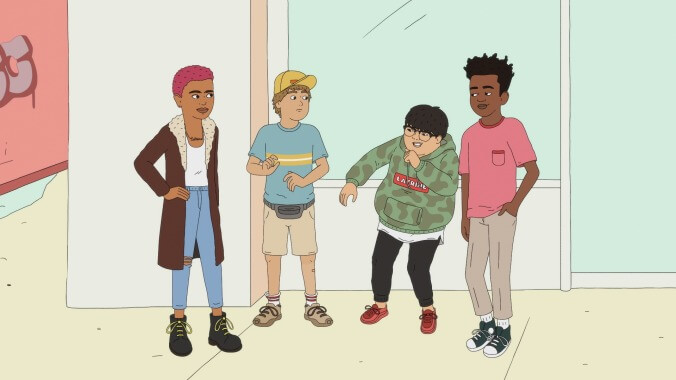Amazon’s Fairfax is as fleeting and insubstantial as a tweet
The new Amazon series, starring Jaboukie Young-White and Kiersey Clemons, doesn't actually seem to understand the internet

In Amazon’s new animated series, Fairfax, the hypebeast brand on everybody’s feeds is LATRINE. Customers line up and down the block of L.A.’s trendy Fairfax Avenue to cop the latest products like the Dr. Phil box T-shirt (sold out immediately) or the LATRINE pencil sharpener (reselling for $900, thanks to a shout-out on Timothée Chalamet’s Instagram). At the heart of the series are four seventh-graders who watch for every LATRINE drop, convinced they have the formula down: Merch equals clout, and clout equals followers, and followers make you into influencers.
Our entry into the world of Fairfax is Dale (Skyler Gisondo), an Oregon transplant who everyone mistakes as normcore when he really just wears hiking boots for the arch support. The crew teaches him that you exist as your brand: Truman (Jaboukie Young-White) is an aspiring filmmaker who posts movie clips at @TruStories69. Activist Derica’s (Kiersey Clemons) feed @tacoboutchange mashes up Mexican food with photos of BLM marches. Benny (Peter S. Kim) poses as a “gangster shoe salesman” at @1YUNGHYUNGH.
Fairfax presents itself as a show for the terminally online. But somehow, it only scratches the surface of the internet culture that makes up its whole premise. The series never explains what it means to be an influencer, or why the crew works so hard to reach this status. In episode two, “Big Peens,” Dale reveals a horrifying fact—he’s never had an Instagram account. In order to get into an influencer’s birthday party, he has to gain 100 followers. The episode has its moments, including every time Dale’s pupils dilate with dopamine hits as his follower count rises.
In Fairfax, Instagram is the only social media with any real sway. But the question remains: Are teens actually using Instagram right now? According to a New York Times article that dropped just two weeks before the show’s premiere, teens do not care about the photosharing-app-turned-whatever-Instagram-is-now. The show’s depiction of teenagers screams “millennial writers’ room.” In 2021, a series about internet-savvy seventh-graders only references TikTok in passing, which means that, for season two, Amazon should probably hire some Gen Z consultants.
Series creators Matt Hausfater, Aaron Buchsbaum and Teddy Riley have called their show “a love letter to kids today—the generation that will most definitely save the world from global warming, if they don’t die from eating Tide Pods first.” Well, Fairfax is about teens, but certainly not for teens. Instead, it’s a voyeuristic glance into the idea of how teens exist today. The show’s social media understanding feels rooted in 2013, a simpler time when Instagram just wanted you to filter the hell out of your breakfast photos.
But the internet has always been weirder, darker, and infinitely more interesting than Fairfax allows it to be. Teens existing as digestible brands dripping in streetwear could delve into all sorts of fascinating avenues about identity, capitalism, and the effects of growing up so logged on. The show never really goes there, though. Instead, each 20-minute episode seems preoccupied with working in poop and fart jokes.
The animation style is the savviest element of the series, with character designs from Internet artist Somehoodlum and art direction from meme factory Pizzaslime. The kids are depicted more realistically than comparable cartoons like Big Mouth. Their outfit details shine with small details, from Benny’s red sneakers to Derica’s cursive LATRINE necklace.
Fairfax seems confused about modern social media, but its streetwear spoofs land. That’s because the spirit of streetwear shows up again and again: constantly referencing and remixing pop culture to create something fresh. From Magritte’s apple-faced businessman to the iconic whale-leap shot from Free Willy, Fairfax drops visual Easter eggs that make watching fun.
The show also shoehorns in lots of references to real-life celebrities, but the funniest jokes come when it creates new ones. The hottest rapper at Fairfax Middle School is Yung Polluter, who spins rhymes like “Throw a cheeseburger out the coupe, we pollutin’.” (Honestly, it’s a bop.) He toes the line between believable and utterly absurd, ending up much more memorable than the bizarre amount of Joaquin Phoenix cameos throughout the season. Most of the celebrity references lack a punchline, as if the famous name itself is a joke that needs no context.
Fairfax’s best moments come when it fully inhabits its own fantasy. So why does it insist on keeping a chokehold on 2021 cultural references that feel stale almost immediately? Why drop Shania Twain into an episode about Yung Polluter’s music festival? Why have the teens use Instagram when the show could invent a new platform, freed from any ties to how the real world works?
In the end, Fairfax feels like a show you put on as background noise while you scroll your phone. It’s as fleeting and insubstantial as a 280-character tweet, a brief blip of a joke that you laugh at and immediately forget. Amazon ordered two eight-episode seasons out of the gate, so maybe future episodes will go deeper into what could be a fascinating and funny look at what it actually means to exist online. Right now, it’s not really worth the follow.